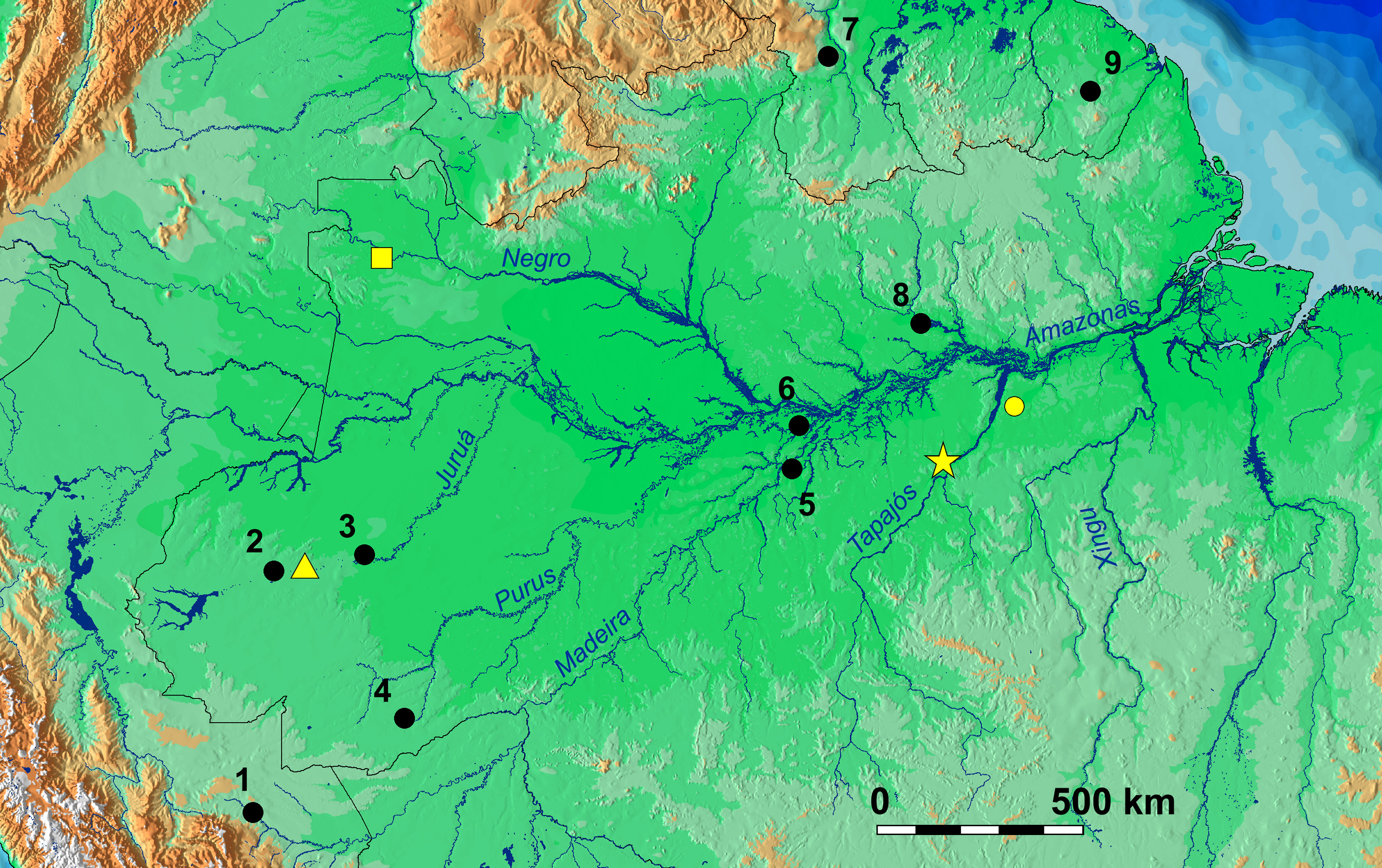Allobates tapajos Lima, Simões & Kaefer, 2015
Description
Diagnosis. A small species of cryptically-colored Allobates. (1) Mean SVL of males 15.5 mm (range 14.9 – 16.2 mm); mean SVL of females 16.3 mm (range 15.5 – 16.8 mm); (2) Dorsal surface of snout uniformly light brown, same color extending posteriorly until eye level; dorsum with irregular dark brown blotches scattered from eye level to urostyle region. Dorsum laterally light brown from eye level to urostyle region, width of light brown area variable; background color of dorsal surfaces of legs light brown; diffuse, weakly conspicuous transverse bands of a darker brown shade sometimes present across dorsal surfaces of thigh (on its proximal region), shank (at mid level) and foot (at mid level); posterior surface of thigh and groin dark brown; skin texture of dorsum smooth, with small granules uniformly scattered from the level of the eyes to posterior edge of dorsum; (3) lateral dark brown band with a diffuse lower edge (4) pale dorsolateral stripe present in preserved specimens, inconspicuous in life; (5) oblique lateral stripe absent, pale cream spots scattered on inguinal region of the lateral dark brown band; (6) pale ventrolateral stripe absent; (7) pale paracloacal mark present, half-moon shaped; (8) throat and chest of males cream in preserved specimens, golden yellow in life; abdominal surfaces white centrally, yellow towards the flanks and ventral surface of legs in live males; (9) throat, chest and abdomen uniformly white to translucent in preserved and in live females; chin light yellow in life, cream in preserved female specimens; (10) dark throatcollar absent; (11) iris is metallic gold, without a pupil ring; (12) median lingual process absent; (13) vocal sac distinct, subgular; (14) maxillary teeth present; (15) third phalange of Finger III not swollen in males, morphology of Finger III similar between males and females; (16) distal tubercle absent on Finger IV; (17) tip of Finger IV not reaching the distal subarticular tubercle of Finger III; (18) tip of Finger II reaching the middle of the distal subarticular tubercle of Finger III; (19) basal webbing present between Toes III and IV, rudimentary basal webbing present between Toes II and III; (20) fringes absent on toes; (21) testes not pigmented, extending one-half the length of kidney; (22) mature oocytes pigmented; (23) eggs laid on opaque jelly nests, on dead leaves on the forest floor; (24) caudal musculature of tadpoles bifurcated dorsally on body region; (25) anterior labium of tadpoles with short round papillae only on lateral margins, 4 – 5 on each side; posterior labium with a single row of marginal papillae variable in length, short and round medially and on the outer lateral folds, elongate between these regions; (26) diurnal habits, males calling in daytime; (27) advertisement calls characterized by the continuous emission of note pairs; notes with ascending frequency modulation with peak frequencies between 5.3 – 5.9 kHz, split by approximately regular silent intervals of 0.30 to 0.49 s; additional call arrangements (random emission of single notes and note trios, and emission of short trills) produced less frequently. The new species is unambiguously assigned to genus Allobates by the combination of the above characters 10, 12, 19, 21, 26. Comparisons with other species. Because the new species is distributed in the Tapajós River basin (see “ Distribution and natural history ” below), comparisons with other Allobates species are limited to all species occurring in Brazil, and to two additional species distributed in the Guiana Shield (Allobates granti and A. amissibilis — Appendix II).
Common Names
No common names available.
Taxonomic Hierarchy
Kingdom: Animalia
Phylum: Chordata
Class: Amphibia
Order: Anura
Family: Aromobatidae
Genus: Allobates
Species: Allobates tapajos Lima, Simões & Kaefer, 2015











